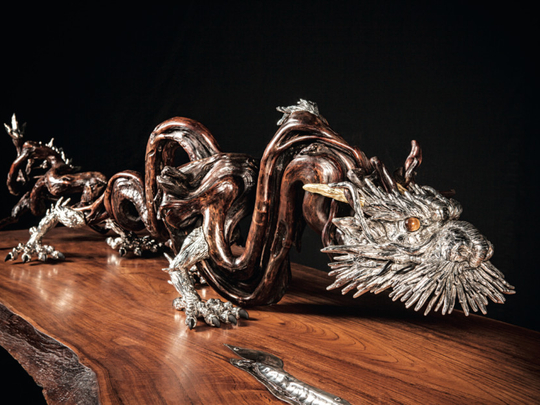
Rolf von Bueren was born in Germany in 1940. He moved to Thailand at the age of 22, and has lived there ever since. His love for Asian culture, arts and crafts led him to open Lotus Arts de Vivre, a store that specialises in exclusive, one of a kind, hand-crafted jewellery, handbags, home décor and accessories.
Besides being the founder and chairman of this iconic Thai brand, von Bueren is also its chief designer. His designs reflect his love for Asian culture, and for nature. He uses natural materials such as seeds, nuts, coconut shells, stingray leather, ostrich and emu eggs, scarab wings, ebony and precious woods, roots, seashells, bamboo and lacquer, combining them with gold, silver, mother-of-pearl and precious stones to create exquisite and unique designs. He works with skilled traditional craftsmen and technicians from around the world to transform these designs into stunning statement pieces.
The first Lotus Arts de Vivre store in this region opened recently in Dubai at City Walk. The luxurious store is a delightful “cabinet of curiosities” filled with beautiful and unusual works of art such as a huge mahogany root transformed into a silver eagle, an aromatic bowl carved from cinnamon sticks, necklaces and bangles carved from wood and studded with precious metals and stones, handbags crafted from carefully restored antique fabrics, intricately carved lacquer boxes, ram horns transformed into candle stands, a tea set made from carved coconut shells lined with silver, artefacts made from stingray leather, and jewellery and other items decorated with iridescent scarab wings.
Rolf von Bueren uses natural materials such as seeds, coconut shells, stingray leather, ostrich and emu eggs, and scarab wings.
Von Bueren spoke to Weekend Review about his design philosophy, inspirations and the stories behind his creations. Excerpts:
Why did you decide to make Thailand your home?
I moved to Thailand on a posting from the German company I was working for. At that time my country was devastated by the war. The post-war mood was grim and life was very difficult. Thailand was just the opposite. There had been no wars for more than 200 years, the people were gentle and warm, the food was great and plentiful, and I was captivated by the Asian culture and eclectic range of ethnicities, dialects, flavours, melodic sounds, traditional arts and crafts, and religious practices. Later, when the company asked me to move to Korea, another post-war country, I chose to give up my job and established my own business in Thailand.
What motivated you to open Lotus Arts de Vivre?
My wife Helen and I have always been interested in art and collecting antiques. When a friend offered me a shop in the then Peninsula Hotel, I decided to take it and persuaded my wife to run it because our sons had left for boarding school in England. She is not commercial-minded, so she began making special designs without worrying about the cost or the market. Soon she had clients flying down from all over Asia to have unique pieces custom-made for them for special occasions. When the business became too big for her to handle, I sold my businesses and stepped in. Our two sons have also joined the business now. We have grown over the last three decades, but we have maintained the brand’s ethos of making special, mostly one-of-a-kind pieces.
Rolf von Bueren with his wife Helen.
What are the inspirations for your designs?
I get inspired by the rich Asian culture, mythology and crafts, and by the materials and organic forms found in nature. We travel 200 days a year, and in every place we go to, we walk around a lot, looking at the shops, observing trends on the streets and visiting flea markets, museums, art galleries and specialist stores. Unlike other designers, I buy the raw material with a specific design in mind. For instance, I bought a particular shell from a shop in Switzerland because I could see the head of the elephant-headed Indian deity Ganesha in its shape. Later we crafted the body from wood and embellished it with mother-of-pearl and precious stones to make a beautiful brooch. Similarly, when I found an interesting teak root, I saw that it could be carved into a bowl.
What are your favourite motifs?
The elephant is a recurring motif in our designs because it is the symbol of Thailand, and a fascinating, magical animal. All the white elephants in Thailand belong to the king and each has a noble title. We were happy to know that an elephant-shaped silver handbag that Michael Jackson had bought from us and gifted to Elizabeth Taylor was recently sold at auction for a very high price. I take inspiration from nature because nature is the best artist and has created the most perfect forms and proportions. But today we are losing touch with nature, so I try to incorporate various other animals, insects and a variety of leaves in my designs. The Chinese dragon is another motif you will see in many of our designs.
How do you blend so many different materials and crafts in one piece?
We work with the best craftsmen for every material, such as gem cutters from India, wood carvers from Indonesia, Cinnabar and Makie lacquer artists in China and Japan, and Niello experts in Thailand. So, different parts of a piece are hand-crafted in different countries, and then put together by experts who have the technical know-how for working with different materials. It is a long, slow process, but that is what makes our creations special. In today’s world, traditional crafts are dying out at an alarming rate because of loss of patronage, competition from cheaper computerised processes, and a younger generation that is not interested in learning the skills of their ancestors. We have sought out the most skilled craftsmen across Asia and the world. It took time and patience to convince the old masters to follow our style of designing using their traditional techniques, but we are happy that we are helping to conserve these age-old processes, and to improve the lives of the craftsmen. One of my proudest moments was when I successfully took on a challenge from the director of the Hermitage Museum to create a replica of a rare carved artefact displayed in the museum.
What is your vision for the brand?
I believe that discerning clients are now moving away from luxury brands and seeking artisanal luxury. They want to own something that is unique. So, our vision for the future is to continue creating beautifully designed and crafted items that make people feel special and enable them to express their individuality.
Jyoti Kalsi is an arts-enthusiast based in Dubai.













